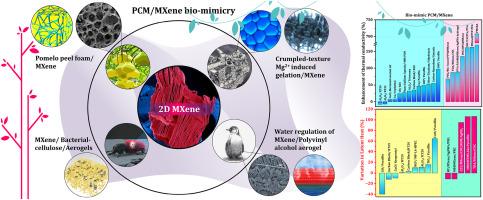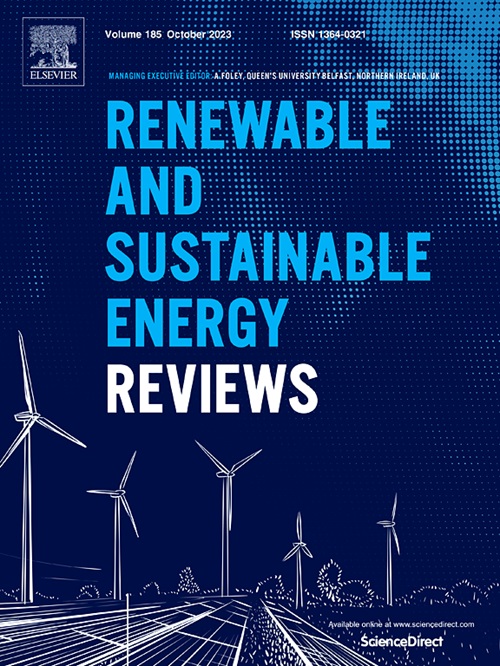MXene based composite phase change materials for thermal energy storage applications: Featuring bio-mimic approaches
IF 16.3
1区 工程技术
Q1 ENERGY & FUELS
引用次数: 0
Abstract
Phase change materials (PCMs) are widely used in thermal energy storage systems, but their underlying drawbacks, such as poor heat conductivity and phase transition leakage, make them unsuitable for widespread use. MXenes have received a lot of curiosity due to having extraordinary mechanical properties, high electrical conductivity, and unique layered structure. Owing to the exquisite arrangements, numerous unique biomimetic morphologies have drawn attention. Numerous investigations regarding bio-mimic MXene/PCM composites (BMX-CPCMs) have found improvements in latent heat up to 106.50 % on average, along with excellent thermal stability with no matrix leakage in 500 cycles and an upsurge in thermal conductivity of up to 708 % as well as better electrical conductivity. These composites exhibit exceptional flame redundancy, a better evaporation rate of 0.92 kg/m2 h, and photothermal conversion efficiency of up to 99.80 %. Certain BMX-CPCMs have superior elasticity and compressibility, with the ability to rebound to nearly the initial stage even after enduring a significant 80 % compression strain deformation. BMX-CPCMs showcase their diverse potential to promote socio-economic and environmental well-being globally, helping to create an evenly distributed and sustainable world by achieving several United Nations Sustainable Development Goals. This work provides a comprehensive analysis of BMX-CPCM for advanced energy storage systems and conversion applications, which will inspire and guide the scientific community in further advancing this field with the focus on developing new materials that mimic nature with controlled structures and properties. These materials are crucial for clean, renewable energy storage and conversion, which are necessary for sustainable societal progress.

基于 MXene 的复合相变材料的热能储存应用:以仿生方法为特色
相变材料(PCM)被广泛应用于热能储存系统,但其潜在的缺点,如导热性差和相变泄漏,使其不适合广泛使用。MXenes 因其非凡的机械性能、高导电性和独特的层状结构而受到广泛关注。由于其精致的排列,许多独特的仿生物形态引起了人们的关注。关于仿生物 MXene/PCM 复合材料(BMX-CPCM)的大量研究发现,其潜热平均可提高 106.50%,同时还具有优异的热稳定性,在 500 次循环中基质不会泄漏,热导率最高可提高 708%,导电性也更好。这些复合材料具有优异的火焰冗余性,蒸发率高达 0.92 kg/m2 h,光热转换效率高达 99.80%。某些 BMX-CPCM 具有优异的弹性和可压缩性,即使在承受 80% 的压缩应变变形后,仍能回弹到接近初始阶段。BMX-CPCM 展示了其在促进全球社会经济和环境福祉方面的各种潜力,有助于通过实现若干联合国可持续发展目标来创建一个分布均匀、可持续发展的世界。这项研究全面分析了 BMX-CPCM 在先进储能系统和转换应用中的应用,将激励和指导科学界进一步推动这一领域的发展,重点开发结构和性能可控的仿自然新材料。这些材料对于清洁、可再生能源的储存和转换至关重要,是社会可持续发展所必需的。
本文章由计算机程序翻译,如有差异,请以英文原文为准。
求助全文
约1分钟内获得全文
求助全文
来源期刊

Renewable and Sustainable Energy Reviews
工程技术-能源与燃料
CiteScore
31.20
自引率
5.70%
发文量
1055
审稿时长
62 days
期刊介绍:
The mission of Renewable and Sustainable Energy Reviews is to disseminate the most compelling and pertinent critical insights in renewable and sustainable energy, fostering collaboration among the research community, private sector, and policy and decision makers. The journal aims to exchange challenges, solutions, innovative concepts, and technologies, contributing to sustainable development, the transition to a low-carbon future, and the attainment of emissions targets outlined by the United Nations Framework Convention on Climate Change.
Renewable and Sustainable Energy Reviews publishes a diverse range of content, including review papers, original research, case studies, and analyses of new technologies, all featuring a substantial review component such as critique, comparison, or analysis. Introducing a distinctive paper type, Expert Insights, the journal presents commissioned mini-reviews authored by field leaders, addressing topics of significant interest. Case studies undergo consideration only if they showcase the work's applicability to other regions or contribute valuable insights to the broader field of renewable and sustainable energy. Notably, a bibliographic or literature review lacking critical analysis is deemed unsuitable for publication.
 求助内容:
求助内容: 应助结果提醒方式:
应助结果提醒方式:


